
Watch the President and the First Lady Welcome the Italian Prime Minister to the State Dinner:
Today, President Obama and First Lady Michelle Obama will host their 14th and final Official State Visit and State Dinner in honor of Prime Minister Renzi of Italy, and his wife Mrs. Agnese Landini. As Chief Curator at the White House since 2002, my job is to oversee the art and décor in the White House, which plays an important role in welcoming heads of state from across the globe. While I've led these efforts for 14 years, I've actually served in the curator's office under seven different administrations, so I've seen this event evolve over the years.
State Dinners are beautiful expressions of friendship and diplomacy, but their history is not necessary well known. So I thought I'd answer a few questions that Americans may have about Official Visits and State Dinners over the years, and what you can expect to see at the last one for the Obamas.
So here’s a deeper dive into the history behind today’s event:
Why are the President and the First Lady hosting Italy for their last official visit?
For President Obama and First Lady Michelle Obama, this visit is an opportunity to recognize the depth and breadth of our relationship with Italy and exchange views on the future of Europe. As the President has said, Italy is one of our closest allies, and we cooperate across a range of shared interests, from addressing climate change and the global refugee crisis to promoting global security and inclusive economic growth.
Watch the Official State Arrival here:
When did the tradition of state visits first begin at the White House?
Today we understand a state dinner to be when the president entertains a counterpart leader of another nation, usually at a gala evening at the White House. But such diplomatic travel was rare prior to World War II. In the 19th century there were three “state dinners” held by the president in an official or “state” capacity each winter -- one for the diplomatic corps (the on-site representatives of other countries), one for the Cabinet, and one the Supreme Court.
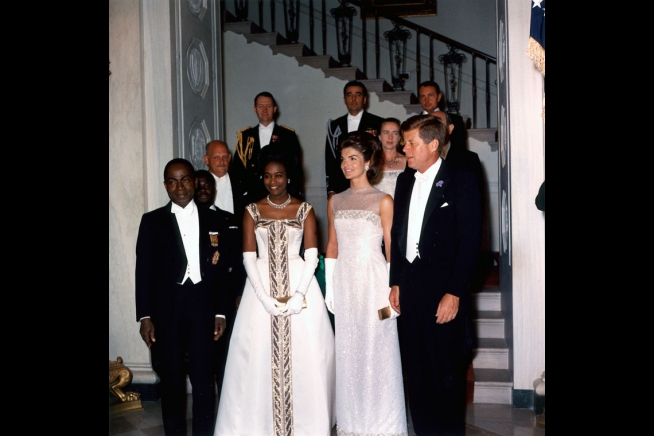
Sometimes visiting members of royal families were asked to similar formal dinners, for example the Prince of Wales, later King Edward VII, in 1860, the Grand Duke Alexis of Russia in 1877, and Princess Eulalia of Spain in 1893. The first actual head of state to visit was David Kalakaua, King of the Hawaiian Islands, received by President and Mrs. Ulysses S. Grant in 1874. State dinners were much smaller then than they are now. Until 1902, a smaller State Dining Room was oriented east-west, with a fireplace at each end. A large dinner could be served at an I-shaped table seating 40-50 people.
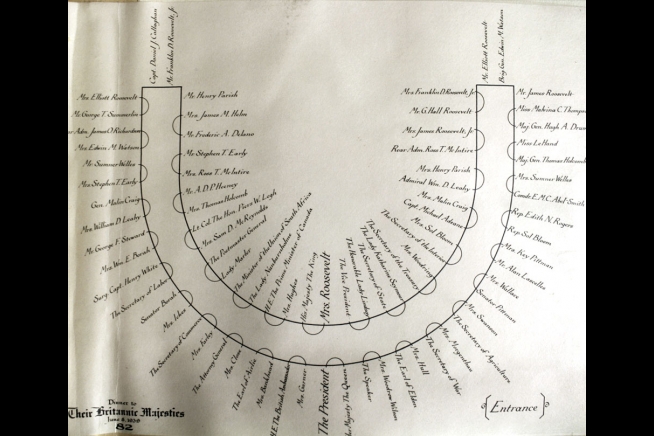
In 1902, President Theodore Roosevelt had a formal dinner for the brother of the Kaiser of Germany, held in the East Room to accommodate the large number of guests, all of them men. The Prince thought himself so above Americans that the German ambassador suggested he should walk into the dinner first and alone, but President Roosevelt responded, “no person living precedes the President of the United States in the White House.”
Today, State Dinners are held in the State Dining Room, with entertainment to follow in the East Room.
Has President Obama made any notable changes to these traditions?
This Administration's dinners have had a great variety of settings from 2009 to 2011: India in 2009 in a tent; Mexico in 2010 with dinner in the East Room and dessert and entertainment in a tent; China in 2011 with dinner in three rooms (State Dining Room, Red Room, and Blue Room) and entertainment in the East Room; and Germany in 2011 in the Rose Garden without a tent. Since then, dinners have either been held in the East Room with entertainment in the State Dining Room (South Korea in 2011, Japan in 2015, China in 2015, Canada in 2016, Singapore in 2016) or dinner and entertainment in a tent (Great Britain in 2012, France in 2014, Nordic in 2016, Italy in 2016).
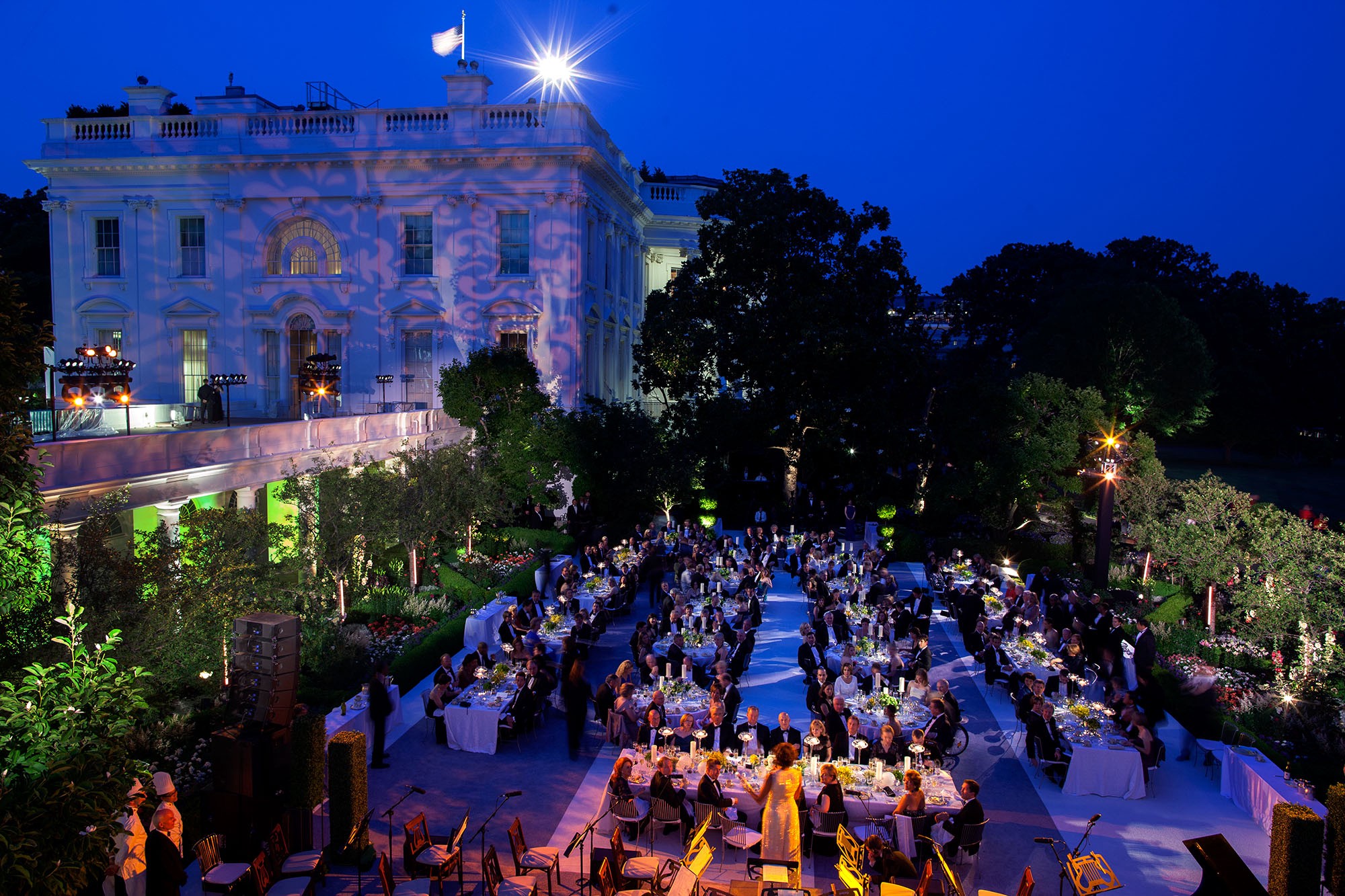
The First Lady hosting tea for the visiting first lady has evolved, at least this Administration, into more unique "spousal events." Recently, the First Lady traveled with the spouses of Nordic leaders to the Renwick Gallery to see the "WONDER" exhibition. She perused the National Gallery with the wife of Singapore’s Prime Minister, and will take a tour of the White House Kitchen Garden with Mrs. Landini.
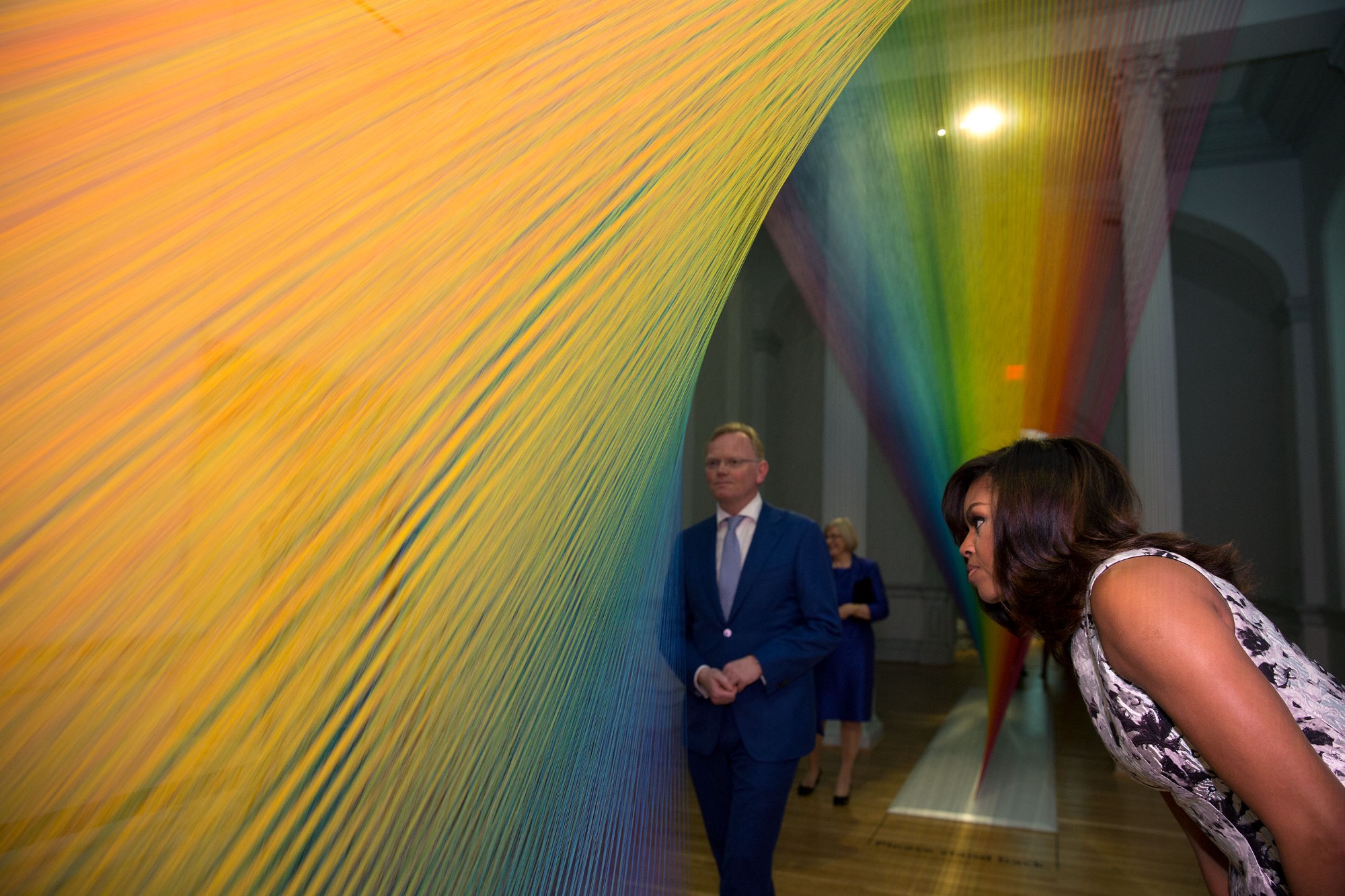
Any memorable moments from past visits and dinners?
One of the most famous state visits was for King George VI of Great Britain in 1939. This visit preceded the tradition of receiving the foreign the leader at a “state arrival” at the White House. Instead, the King and Queen, arriving from Canada by train, were met by President and Mrs. Franklin D. Roosevelt at Union Station, and then proceeded to the White House in a military parade witnessed by half a million people. There was a grand dinner at the White House. Although the King toasted to friendship in a world of peace, two months later World War II broke out in Europe. That state visit was more famous, however, for a follow-up picnic at the Roosevelts' home at Hyde Park, New York, where the King and Queen were offered hotdogs.
For the state dinner for the President of Sudan in 1961, Mrs. Kennedy invited the teenaged daughters of Vice President Lyndon Johnson because she thought they would enjoy the after-dinner entertainment by the American Shakespeare Festival Theater. The girls telephoned to be sure there was no mistake, since they were only 17 and 14, but Mrs. Kennedy assured them she wanted them there. Mrs. Johnson, however, told them to avoid the wines.
Not every state dinner has gone off without a hitch.
In 1927, at a dinner for the President of Cuba given by President and Mrs. Calvin Coolidge, a guest managed to break through the caning of the dining table chair, so that when he stood up, the chair remained stuck to his posterior.
In 1976 to honor the bicentennial of the American Revolution, a dinner for Queen Elizabeth II was given by President and Mrs. Gerald Ford in a tent in the Rose Garden (the first Rose Garden dinner had been held in 1964 by President and Mrs. Lyndon Johnson). But most of the Residence staff rushed outside during an afternoon thunderstorm to hold down the tent ropes.
In 1991, the absence of a step left Queen Elizabeth II without the proper elevation for the state arrival podium, resulting in her being called "the talking hat."
And in 1994, at a Rose Garden dinner for the Emperor of Japan, one important dinner guest failed to arrive, so the social secretary recruited a last second replacement. I was that very nervous stand-in.
What can we expect to see during this visit?
The President and First Lady will welcome the Italian Prime Minister and his wife in an Official Visit Ceremony on the South Lawn of the White House. Both Prime Minister Renzi and President Obama will offer brief remarks and then proceed into the White House for a bilateral meeting before holding a press conference with both U.S. and Italian reporters.
In the evening, the Prime Minister and Mrs. Landini will return to the White House where they will enjoy a dinner in a tent on the South Lawn. That’s where guests will see how the White House has weaved Italian influence into the art, décor, and entertainment.
How has the White House reflected Italian culture in tonight’s dinner?
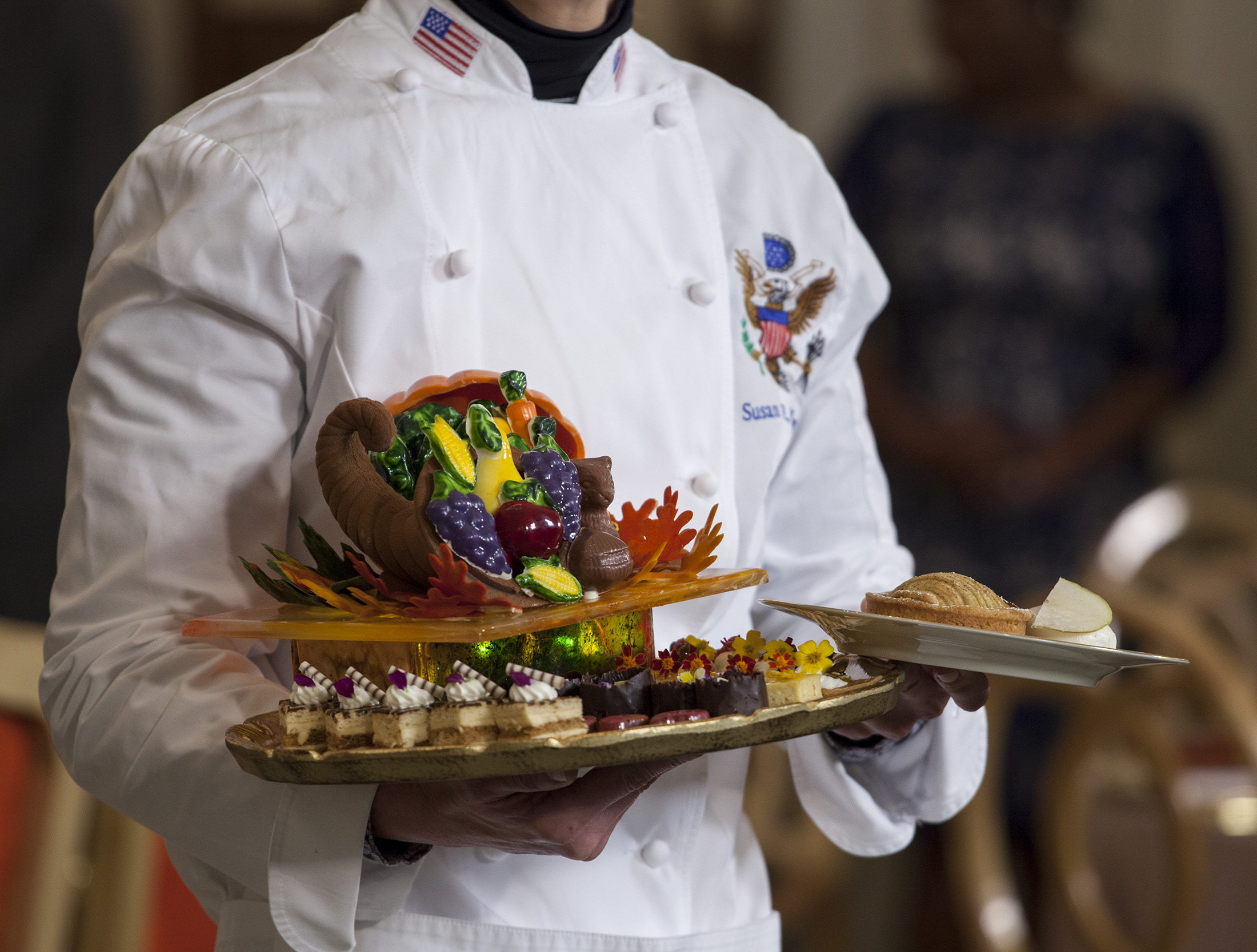 The décor is meant to celebrate the Italian influence on American culture and society, and the partnership between our two countries. It’s inspired by an Italian design technique called fresco, meaning “fresh” in Italian. Detailed chandeliers will hang from the ceiling of the tent, a portion of the tables will have mirrors that reflect the candlelight on the table and the floral arrangements, and each table will feature handmade glassware and neo-florentine charger plates.
The décor is meant to celebrate the Italian influence on American culture and society, and the partnership between our two countries. It’s inspired by an Italian design technique called fresco, meaning “fresh” in Italian. Detailed chandeliers will hang from the ceiling of the tent, a portion of the tables will have mirrors that reflect the candlelight on the table and the floral arrangements, and each table will feature handmade glassware and neo-florentine charger plates.
For music, there have certainly been musical performers -- guests or military ensembles -- since Truman. Tonight, guests will be welcomed with an a capella performance by students from Rosie’s Theater Kids. Following dinner, the White House will host a musical performance by three-time Grammy Award winner Gwen Stefani.
And of course, the food. This time around, White House Executive Chef Cris Comerford and White House Executive Pastry Chef Susan Morrison collaborated with guest Chef Mario Batali -- a world-renowned chef and restaurateur who spent three years training in a small Northern Italian village. The courses will feature traditional Italian dishes that have been ingrained in American cuisine. You can see the menu here.
Which state visit will you most remember under this Administration?
I will most remember the Nordic dinner because, after helping curate the White House for decades, I finally got to attend as an invited guest. It was unusual dinner for having five nations -- one head of state and four chiefs of government, and it was held in a tent outside.
You can take a look back at all the Official State Visits under the Obama administration here, thanks to my colleague Chief White House Photographer Pete Souza.
Bill Allman is the Chief Curator of the White House.

